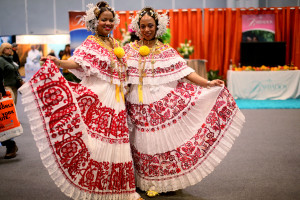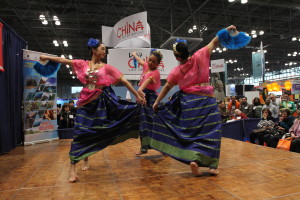Each winter, the New York Times Travel Show draws hundreds of exhibitors — national tourism bureaus, tour operators, and various travel-related organizations, among others — to meet the public and try to lure them to their destination or onto their tours and the like. It’s the largest such trade and consumer show in North America.
There are also dozens of travel-related talks and seminars you can attend led by veteran travel writers, publishers and broadcasters, some beautifully costumed women dancing on stages representing various nationalities, some free food giveaways, a number of special travel discounts good only at the show, and various other enticements.
With winter slush outside, it’s the perfect time to get people thinking about warm-weather destinations or at least traveling somewhere when the weather gets warm.
I was there this weekend making contacts for StrideTravel.com, the new travel website I work for, and I noticed some trends worthy of mention:
* Based on the number of people swarming around the tour operators who send people to Cuba, that long-boycotted (by America) island nation is just about the hottest destination — or at least wished-for destination — going. “Our phones have been ringing off the hook,” one authorized Cuba tour operator told me.
The spur for all this activity, as most everyone is aware, was President Obama’s recent initiative to normalize relations with the Castro-run regime, which have been stifled for decades. Except for a few less bureaucratic hoops to jump through. though, the travel rules for Americans haven’t really changed much — yet.
Unless a U.S. citizen fits into one of various special categories, you still have to travel with one of the “people-to-people” tours that emphasize cultural contacts with the Cuban people, offered by several companies, including Road Scholar, a tour company that focuses largely on learning experiences for baby boomers. (Road Scholar, which has been offering such tours for five years but is now besieged with requests, was at the Times Travel Show.)
This isn’t really a bad thing — most of the tours are great — but it means that U.S. citizens can’t join their neighbors in Canada, for instance, on a strictly beach or sightseeing vacation in Cuba. It’s obvious that many Americans are clamoring for just that, however. Stay tuned for further developments.
* Mongolia is another hot destination that (unlike, say, Burma/Myanmar) has been largely off the radar until now. “People are tired of going to China,” one of several tour operators offering Mongolia trips told me. “Mongolia’s capital (Ulaan-Baatar) is only an hour and a half flight from Beijing, but people think of it as so remote,” she noted. “So you can go somewhere ‘remote’ that really isn’t hard to get to.”
In Mongolia, you can discover one of the last true nomadic cultures, stay in gers (yurts), ride horseback over the steppes if you’re so inclined, relive the days of Genghis Khan, visit the Gobi Desert or the Altai Mountains, and attend colorful festivals (such as Naadam, which features the sports of wrestling, horse racing and archery). If all that intrigues you, Blue Silk Travel, based in Ohio, specializes exclusively in Mongolia tours. Alpine Expeditions, based in Alaska, offers horseback trips in Mongolia.
* Customized tours are a hot trend. While guided group tours with pre-set itineraries are a staple of the industry, customization — in which a tour operator expert in a particular area arranges a trip to your specifications — is coming on strong.
Most often, the operator customizes a trip after consulting with the travelers (often couples, friends, or families) on what they’d like to do and see, and then sets up appropriate lodgings, guides, meals (in many cases), and all the transportation as well (often, but not always, including international airfare to the destination).
The traveler pays one price and may only be responsible for the cost of souvenirs, personal expenses and perhaps tips (though those may be included as well). The key difference from a regular guided tour, though, is that you get to call the shots, but be able to rely on the expertise of the tour operator to make sure those shots hit the mark. A good custom tour operator will provide support services during the trip if needed.
Not only were a number of tour operators at the Times Travel Show offering strictly custom trips, but a sizable percentage of more traditional tour operators emphasized that they, too, would customize a trip if requested. Expect to pay more, in general, for a customized tour than a group tour.
Two tour operators among many at the Travel Show that offer customized trips are Audley, based in Boston, and Infinite Safari Adventures, based in California.
I’ll have more on the New York Times Travel Show in my next post.
Photos courtesy of the New York Times Travel Show.















One Response to Things I Learned at the NY Times Travel Show